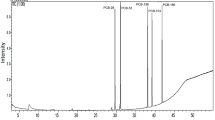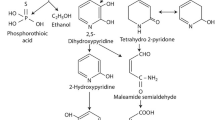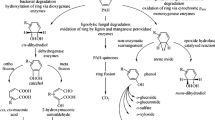Abstract
Soil contamination with benzene, toluene, ethylbenzene and xylene isomers (BTEX) has raised increasing concern because of its high solubility in water and toxicity to biotic communities. This study aims at investigating the process and prospects of deploying bioelectrochemical system (BES) for the removal of BTEX from artificially contaminated soil using Pseudomonas putida YNS1, alongside the reduction of hexavalent chromium (Cr(VI)). The BES was setup with desired operating conditions: initial concentration of BTEX (50–400 mg/L in 100 mL of sterilized water), pH (4–10) and applied potential voltage (0.6–1.2 V) with 10 μL log-phase culture along with the addition of Cr(VI) (10 mg/L). Samples were collected at regular intervals and analysed for BTEX degradation using gas chromatography and Cr(VI) reduction using UV–Vis spectrophotometer. Under optimized conditions (initial BTEX concentration, 200 mg/L; pH 7; and applied voltage 0.8 V with Cr(VI) of 10 mg/L), 92% of BTEX was degraded and 90% Cr(VI) was reduced from the contaminated soil. The intermediates produced during degradation were analysed through gas chromatography-flame ionization detector (GC-FID), and the possible degradation pathway was elucidated. The results indicated that BES could be effective for simultaneous degradation of BTEX along with Cr(VI) reduction.







Similar content being viewed by others
References
Akmirza I, Pascual C, Carvajal A, Pérez R, Muñoz R, Lebrero R (2017) Anoxic biodegradation of BTEX in a biotrickling filter. Sci Total Environ 587:457–465
AWWA, 1998. Stand. Methods Exam. Water Wastewater, 20th ed. Am. Public Heal. Assoc. Washington, DC
Babaarslan C, Tekeli A, Mehmetoğlu T (2003) Biodegradation of BTEX compounds by a mixed culture obtained from petroleum formation water. Energy Sources 25:733–742
Chang S-H, Wu C-H, Wang R-C, Lin C-W (2017) Electricity production and benzene removal from groundwater using low-cost mini tubular microbial fuel cells in a monitoring well. J Environ Manag 193:551–557
Cristaldi A, Conti GO, Jho EH, Zuccarello P, Grasso A, Copat C, Ferrante M (2017) Phytoremediation of contaminated soils by heavy metals and PAHs. A brief review. Environ Technol Innov 8:309–326
Daghio M, Aulenta F, Vaiopoulou E, Franzetti A, Arends JB, Sherry A, Suárez-Suárez A, Head IM, Bestetti G, Rabaey K (2017) Electrobioremediation of oil spills. Water Res 114:351–370
Daghio M, Tofalos AE, Leoni B, Cristiani P, Papacchini M, Jalilnejad E, Bestetti G, Franzetti A (2018) Bioelectrochemical BTEX removal at different voltages: assessment of the degradation and characterization of the microbial communities. J Hazard Mater 341:120–127
Deeb RA, Hu H-Y, Hanson JR, Scow KM, Alvarez-Cohen L (2001) Substrate interactions in BTEX and MTBE mixtures by an MTBE-degrading isolate. Environ Sci Technol 35:312–317
Dong C-D, Tsai M-L, Chen C-W, Hung C-M (2017) Heterogeneous persulfate oxidation of BTEX and MTBE using Fe3O4−CB magnetite composites and the cytotoxicity of degradation products. Int Biodeterior Biodegradation 124:109–118
Dou J, Liu X, Hu Z (2008) Substrate interactions during anaerobic biodegradation of BTEX by the mixed cultures under nitrate reducing conditions. J Hazard Mater 158:264–272
Duruibe JO, Ogwuegbu M, Egwurugwu J (2007) Heavy metal pollution and human biotoxic effects. Int J Phys Sci 2:112–118
El-Naas MH, Acio JA, El Telib AE (2014) Aerobic biodegradation of BTEX: progresses and prospects. J Environ Chem Eng 2:1104–1122
Freitas JG, Mocanu MT, Zoby JLG, Molson JW, Barker JF (2011) Migration and fate of ethanol-enhanced gasoline in groundwater: a modelling analysis of a field experiment. J Contam Hydrol 119:25–43
Gill R, Harbottle MJ, Smith J, Thornton S (2014) Electrokinetic-enhanced bioremediation of organic contaminants: a review of processes and environmental applications. Chemosphere 107:31–42
González JL, Pell A, López-Mesas M, Valiente M (2017) Simultaneous determination of BTEX and their metabolites using solid-phase microextraction followed by HPLC or GC/MS: an application in teeth as environmental biomarkers. Sci Total Environ 603:109–117
Haigler B, Pettigrew CA, Spain J (1992) Biodegradation of mixtures of substituted benzenes by Pseudomonas sp. strain JS150. Appl Environ Microbiol 58:2237–2244
Hamed TA, Bayraktar E, Mehmetoğlu T, Mehmetoğlu Ü (2003): Substrate interactions during the biodegradation of benzene, toluene and phenol mixtures. Process Biochem 39:27–35
Hu Y, Zhu J, Liu Y (2017) Removal of chromium (VI) from aqueous solutions by electrochemical reduction–precipitation. Int J Electrochem Sci 12:11387–11396
Jo M-S, Rene ER, Kim S-H, Park H-S (2008) An analysis of synergistic and antagonistic behavior during BTEX removal in batch system using response surface methodology. J Hazard Mater 152:1276–1284
Junfeng D, **ang L, Zhifeng H (2008) Anaerobic BTEX degradation in soil bioaugmented with mixed consortia under nitrate reducing conditions. J Environ Sci 20:585–592
Kamala-Kannan S, Krishnamoorthy R (2006) Isolation of mercury resistant bacteria and influence of abiotic factors on bioavilability of mercury - a case study in Pulicat lake North of Chennai, South East India. Sci Total Environ 367:341–353
Khodaei K, Nassery HR, Asadi MM, Mohammadzadeh H, Mahmoodlu MG (2017) BTEX biodegradation in contaminated groundwater using a novel strain (Pseudomonas sp. BTEX-30). Int Biodeterior Biodegradation 116:234–242
Kulkarni PS, Deshmukh PG, Jakhade AP, Kulkarni SD, Chikate RC (2017) 1, 5 diphenyl carbazide immobilized cross-linked chitosan films: an integrated approach towards enhanced removal of Cr (VI). J Mol Liq 247:254–261
Kurniawan TA, Chan GY, Lo W-H, Babel S (2006) Physico–chemical treatment techniques for wastewater laden with heavy metals. Chem Eng J 118:83–98
Leson G, Winer AM (1991) Biofiltration: an innovative air pollution control technology for VOC emissions. J Air Waste Manage Assoc 41:1045–1054
Li H, Liu YH, Luo N, Zhang XY, Luan TG, Hu JM, Wang ZY, Wu PC, Chen MJ, Lu JQ (2006) Biodegradation of benzene and its derivatives by a psychrotolerant and moderately haloalkaliphilic Planococcus sp. strain ZD22. Res Microbiol 157:629–636
Li X, Zheng R, Zhang X, Liu Z, Zhu R, Zhang X, Gao D (2019) A novel exoelectrogen from microbial fuel cell: bioremediation of marine petroleum hydrocarbon pollutants. J Environ Manag 235:70–76
Morlett-Chávez JA, Ascacio-Martínez JÁ, Rivas-Estilla AM, Velázquez-Vadillo JF, Haskins WE, Barrera-Saldaña HA, Acuña-Askar K (2010) Kinetics of BTEX biodegradation by a microbial consortium acclimatized to unleaded gasoline and bacterial strains isolated from it. Int Biodeterior Biodegradation 64:581–587
Rabaey K, Boon N, Höfte M, Verstraete W (2005) Microbial phenazine production enhances electron transfer in biofuel cells. Environ Sci Technol 39:3401–3408
Shim H, Shin E, Yang S-T (2002) A continuous fibrous-bed bioreactor for BTEX biodegradation by a co-culture of Pseudomonas putida and Pseudomonas fluorescens. Adv Environ Res 7:203–216
Słomińska M, Król S, Namieśnik J (2013) Removal of BTEX compounds from waste gases; destruction and recovery techniques. Crit Rev Environ Sci Technol 43:1417–1445
Tchounwou PB, Yedjou CG, Patlolla AK, Sutton DJ (2012) Heavy metal toxicity and the environment, molecular, clinical and environmental toxicology. Springer, pp:133–164
Watts RJ, Teel AL (2005) Chemistry of modified Fenton’s reagent (catalyzed H2O2 propagations–CHP) for in situ soil and groundwater remediation. J Environ Eng 131:612–622
Wongbunmak A, Khiawjan S, Suphantharika M, Pongtharangkul T (2017) BTEX-and naphthalene-degrading bacterium Microbacterium esteraromaticum strain SBS1-7 isolated from estuarine sediment. J Hazard Mater 339:82–90
Yang T (2015) Dynamic assessment of environmental damage based on the optimal clustering criterion–taking oil spill damage to marine ecological environment as an example. Ecol Indic 51:53–58
Yanto DHY, Tachibana S (2014) Potential of fungal co-culturing for accelerated biodegradation of petroleum hydrocarbons in soil. J Hazard Mater 278:454–463
You Y, Shim J, Cho CH, Ryu MH, Shea PJ, Kamala-Kannan S, Chae JC, Oh BT (2013) Biodegradation of BTEX mixture by Pseudomonas putida YNS1 isolated from oil-contaminated soil. J Basic Microbiol 53:469–475
Zhu L, Wang Y, Jiang L, Lai L, Ding J, Liu N, Li J, **ao N, Zheng Y, Rimmington GM (2015) Effects of residual hydrocarbons on the reed community after 10 years of oil extraction and the effectiveness of different biological indicators for the long-term risk assessments. Ecol Indic 48:235–243
Funding
This work was supported by the BK21 plus program through the National Research Foundation (NRF) funded by the Ministry of Education of Korea and supported by the National Research Foundation of Korea (Nano-Material Fundamental Technology Development, 2016M3A7B4909370).
Author information
Authors and Affiliations
Corresponding authors
Additional information
Responsible editor: Bingcai Pan
Publisher’s note
Springer Nature remains neutral with regard to jurisdictional claims in published maps and institutional affiliations.
Electronic supplementary material
ESM 1
(DOCX 1721 kb)
Rights and permissions
About this article
Cite this article
Mohan, H., Lim, JM., Cho, M. et al. Remediation of BTEX and Cr(VI) contamination in soil using bioelectrochemical system—an eco-friendly approach. Environ Sci Pollut Res 27, 837–845 (2020). https://doi.org/10.1007/s11356-019-07029-2
Received:
Accepted:
Published:
Issue Date:
DOI: https://doi.org/10.1007/s11356-019-07029-2




